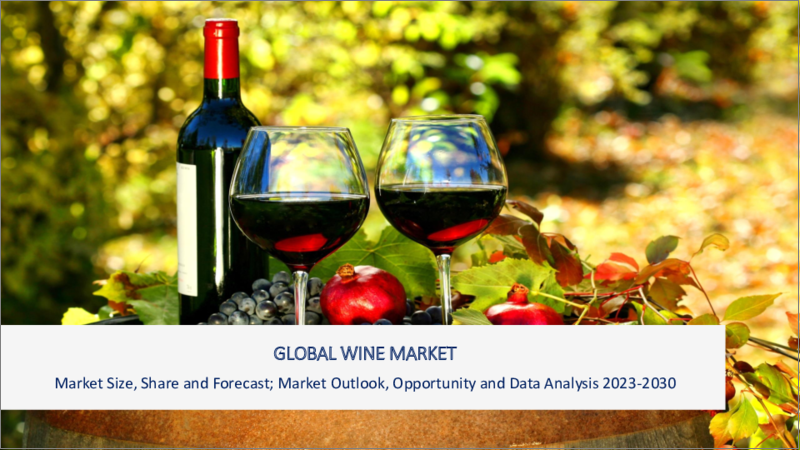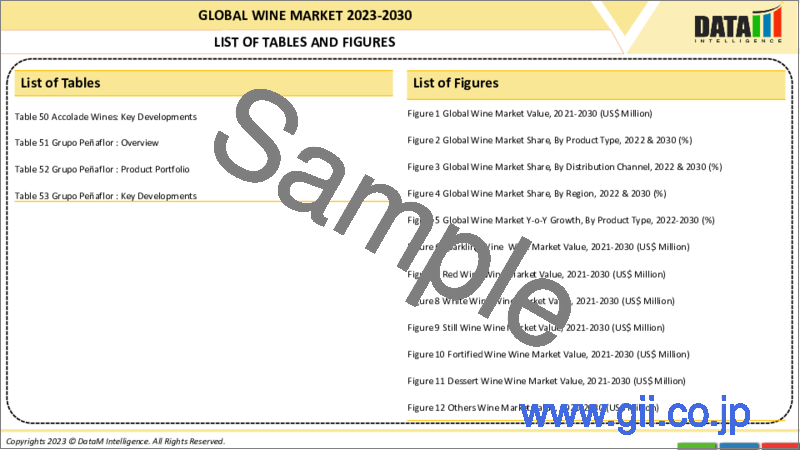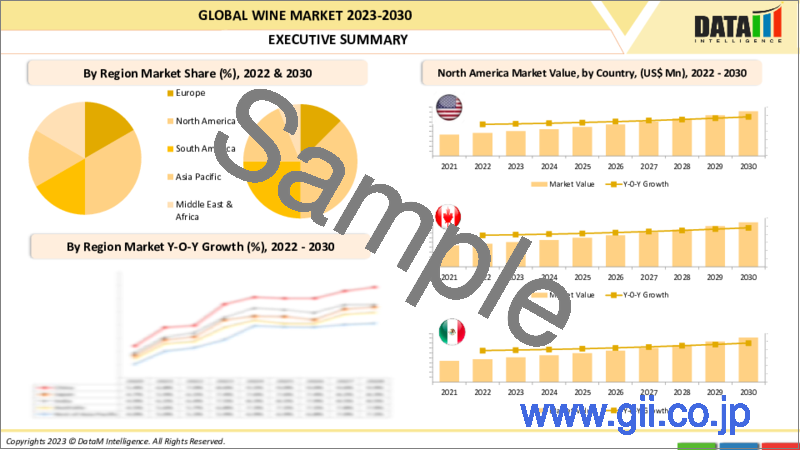|
|
市場調査レポート
商品コード
1319225
ワインの世界市場-2023年~2030年Global Wine Market - 2023-2030 |
||||||
カスタマイズ可能
適宜更新あり
|
|||||||
| ワインの世界市場-2023年~2030年 |
|
出版日: 2023年07月31日
発行: DataM Intelligence
ページ情報: 英文 158 Pages
納期: 即日から翌営業日
|
- 全表示
- 概要
- 目次
市場概要
世界のワイン市場は2022年に4,025億米ドルに達し、2030年には6,037億米ドルに達し、予測期間2023-2030年のCAGRは5.2%で成長すると予測されています。世界の多くの地域でワイン生産と消費の需要が増加していることが、世界のワイン市場の成長機会を後押ししています。
健康上の利点とプレミアム化によるワイン需要の増加が、ワイン市場の成長と拡大を後押ししています。新しい風味の革新と流通パターンの世界の進歩が、市場の成長を促進しています。高級ワインは代替資産クラスとして人気を博しており、高級品分野の拡大を後押ししています。世界のワイン市場の将来を左右するブドウ園での技術利用を含め、ワイン造りには多くの新しい技術や動向が登場しています。
消費者の間で健康志向が高まっています。人々は、同じ雰囲気を感じながらも健康的なノンアルコールワインを採用したいと考えています。製品タイプは、このようなノンアルコールワインの製造に力を入れています。例えば、ヌル・ワインズ・スパークリング・ヴェルデホは、コロンヌ・ヌル・ヴェルデホによるアルコールフリーの白ワインです。ビーガン、低カロリー、ノンアルコールといった特質から人気が高まっています。
市場力学
ワインに関連する健康上の利点が市場成長を牽引しています
赤ワインは心臓の健康に良いです。赤ワインには、冠動脈疾患の予防に役立つ抗酸化物質が多く含まれています。ピノ・ノワール・ワインは最も健康的なワインと評価されています。これはレスベラトロールが多く含まれているためです。ピノ・ノワールは皮の薄いブドウ品種で造られ、糖分が少なく、カロリーが低く、アルコール度数も低いです。イタリアで造られるサグランティーノは、抗酸化物質を最も多く含み、タンニンが詰まっています。
テロワールはブドウ栽培において重要視されています。テロワールは、ワインの官能的特性をブドウが栽培される環境条件と関連付けるものです。ワインの生産条件や発酵中の酵母の含有量は、ワインの栄養表示に影響します。消費者レベルでのワインのテイスティングは、一般的にワインの専門家が行うテイスティングよりもはるかに厳密ではないが、飲料としてのワインの人気の高まりと、その結果としての世界のワイン生産の拡大に伴って増加しています。
新製品の発売と買収が世界のワイン市場の成長を牽引します
主要な市場プレーヤーは、世界のカバレッジを拡大するために強力な戦略を採用しています。消費者の変化パターンを考慮し、消費者のニーズに応えるため、製品ポートフォリオに新しいバリエーションを導入しています。世界のワイン市場の将来を左右するワイン醸造には、多くの新技術や動向が登場しています。
ワイン市場は、その健康効果による需要の増加、ワイン製品のプレミアム化、風味の革新、世界の流通網の高度化によって牽引される可能性が高いです。ポートワインやシェリー酒などの酒精強化ワインにはブランデーが添加されています。
新たな買収が市場拡大を加速させています。例えば、2022年10月、オーストラリアの世界のワイン醸造・販売事業者であるトレジャリー・ワイン・エステーツ社は、フランスのボルドーで最も古いエステートの一つであるシャトー・ラネッサンの買収完了を発表しました。この買収は、ペンフォールド社の複数地域にまたがる高級ワイン・ポートフォリオの強化に向けた最新の一歩です。
気候変動問題が市場の成長を抑制しています
温室効果ガスの大気中濃度の変化や、森林伐採、砂漠化、都市化による地表面の変化により、過去数十年間、気候変動が起きています。気候変動が果たす役割は、気候変動に対して持続的な反応を示すすべての作物において大きいです。特にワイン用ブドウのような特殊作物で顕著です。ワインは熟成するほど美味しくなります。ワインの熟成には適切な条件が必要。
具体的な気候の影響としては、世界の多くの地域で豪雨が増加し、熱波の頻度が増加し、極端な寒暖差や寒波の頻度が減少しています。さらに、米国西部、オーストラリア、ポルトガルで大規模な火災が発生し、一部の地域ではブドウ栽培とワイン生産に影響が出ました。ある品種の最大50%を失った生産者もいれば、2022年に無傷だった生産者もいます。
COVID-19影響分析
COVID-19分析には、COVID前シナリオ、COVIDシナリオ、COVID後シナリオが含まれ、価格力学(COVID前シナリオと比較したパンデミック中およびパンデミック後の価格変動を含む)、需給スペクトラム(取引制限、封鎖、およびその後の問題による需要と供給のシフト)、政府の取り組み(政府機関による市場、セクター、産業を復興させる取り組み)、メーカーの戦略的取り組み(COVID問題を緩和するためにメーカーが行ったことをここで取り上げる)が含まれます。
目次
第1章 調査手法と調査範囲
第2章 市場の定義と概要
第3章 エグゼクティブサマリー
第4章 市場力学
- 市場への影響要因
- 促進要因
- 抑制要因
- 機会
- 影響分析
第5章 産業分析
- ポーターのファイブフォース分析
- サプライチェーン分析
- 価格分析
- 規制分析
第6章 COVID-19分析
第7章 製品タイプ別
- スティルワイン
- スパークリングワイン
- 酒精強化ワイン
- デザートワイン
第8章 流通チャネル別
- オンライン販売
- オフライン販売
- スーパーマーケット&ハイパーマーケット
- 専門店
- その他
第9章 地域別
- 北米
- 米国
- カナダ
- メキシコ
- 欧州
- ドイツ
- 英国
- フランス
- イタリア
- スペイン
- その他欧州
- 南米
- ブラジル
- アルゼンチン
- その他南米
- アジア太平洋
- 中国
- インド
- 日本
- オーストラリア
- その他アジア太平洋地域
- 中東・アフリカ
第10章 競合情勢
- 競合シナリオ
- 市況/シェア分析
- M&A分析
第11章 企業プロファイル
- Castle Freres
- 会社概要
- 製品ポートフォリオと説明
- 財務概要
- 主な発展
- Pernod Ricard
- Constellation Brands
- EJ Gallo
- Treasury Wine Estate
- Vina Concho Y Toro
- Accolade Wines
- Grupo Penaflor
- Fecovita Co-op
- The Wine Group
第12章 付録
Market Overview
The Global Wine Market reached US$ 402.5 billion in 2022 and is expected to reach US$ 603.7 billion by 2030 and grow with a CAGR of 5.2% during the forecast period 2023-2030. The increase in demand for wine production and consumption over many regions of the world is boosting the global wine market growth opportunities.
The increasing demand for wine due to its health benefits and premiumization drives the wine market's growth and expansion. The new flavor innovation and more global advancement in distribution patterns are fueling the market growth. High-end wines have gained popularity as alternative asset classes, which fuels the expansion of the luxury sector. So many new technologies and trends are emerging in winemaking, including technology usage in the vineyard to influence the future of the global wine market.
There is an increasing health preference among consumers. People want to adopt non-alcoholic wines to feel the same vibe but in a healthy manner. Manufacturers are focussing on these types of non-alcoholic wine productions. For instance, Null Wines Sparkling Verdejo is an alcohol-free white wine by Kolonne Null-Verdejo. It is growing in popularity because of its qualities, such as vegan, low-calorie, and non-alcoholic.
Market Dynamics
Health Advantages Associated with Wine are Driving the Market Growth.
The red wine is good for heart health. Red wine contains a good amount of antioxidants that help to prevent coronary artery disease. Pinot Noir Wine is rated as the healthiest wine. This is because of the high levels of resveratrol. It is made of grape varieties with thin skin, has low sugar, fewer calories, and low alcohol content. Sagrantino, made in Italy, contains the highest concentration of antioxidants and is packed with tannins.
The terroir is given high importance in viticulture. It relates the sensory attributes of wine to the environmental conditions in which the grapes are grown. The conditions of wine production and the yeast content in wine fermentation affect the wine's nutritional labeling. Wine tasting at the consumer level though generally far less exacting than that performed by wine professionals, has increased with the growing popularity of wine as a beverage and the resulting expansion of wine production worldwide.
The New Product Launches and Acquisition Drive the Global Wine Market Growth.
The key market players are adopting powerful strategies to extend their global coverage. Considering the changing patterns of consumers, they are introducing new variants in the product portfolio to cater to the needs of consumers. So many new technologies and trends are emerging in winemaking to influence the future of the global wine market.
The wine market is likely driven by the increasing demand due to its health benefits and premiumization of wine products, flavor innovation, and more advanced distribution networks globally. Fortified wines, such as port and sherry, contain added brandy.
New acquisitions are increasing the market expansion. For instance, in October 2022, Treasury Wine Estates Ltd, an Australian global winemaking and distribution business, announced the completion of the acquisition of Chateau Lanessan, one of the oldest estates in Bordeaux, France. This acquisition is the latest step in strengthening Penfold's multi-regional luxury wine portfolio.
Climate Change Problems are Restraining The Market Growth.
There has been an occurrence of climate change for the past several decades because of changing atmospheric concentrations of greenhouse gases and alteration of the earth's surface through deforestation, desertification, and urbanization. The role of climate change is substantial across All crops that show sustainable responses to climate change. It is particularly noticeable for specialty crops such as wine grapes. Wine tastes better with age. Proper conditions need to be followed in wine aging.
Specific climatic effects have included increased heavy rainfall across many regions globally, more frequent heatwaves, and less frequent extreme cold temperatures and cold waves. Additional impacts have been seen in large fires in the western United States, Australia, and Portugal, which have affected grape growing and wine production in some regions. Some growers lost up to 50% of certain varietals, while others were unscathed in 2022.
COVID-19 Impact Analysis
The COVID-19 Analysis includes Pre-COVID Scenario, COVID Scenario and Post-COVID Scenario along with Pricing Dynamics (Including pricing change during and post-pandemic comparing it with pre-COVID scenarios), Demand-Supply Spectrum (Shift in demand and supply owing to trading restrictions, lockdown, and subsequent issues), Government Initiatives (Initiatives to revive market, sector or Industry by Government Bodies) and Manufacturers Strategic Initiatives (What manufacturers did to mitigate the COVID issues will be covered here).
Segment Analysis
The global wine market is segmented based on product type, distribution channel, and region.
In the Global Wine Market, the Sparkling Wine Segment Holds the Largest Market Share.
The global wine market has been segmented by product type into sparkling wines, still wine, fortified wine, and dessert wine. The sparkling wine segment held the most significant wine market share of 38.8% in 2022 in the wine market analysis report. The sparkling wine segment is sub-segmented into champagne, prosecco, and others. Sparkling wines are becoming increasingly popular, leading to the segment's growth.
The sparkling wine provides good health benefits, including its ability to improve cognitive function and gut health. Sparkling wines contain high phenolic acid content. They help to digest fiber, keep the immune system in check, improve mental health, and ward off disease microorganisms. All these health benefits are driving the segment's popularity.
Geographical Analysis
The Europe Region Held the Largest Share of the Global Wine Market.
The global wine market is segmented into five parts based on geography: North America, South America, Europe, Asia-Pacific, the Middle East, and Africa. The Europe wine market held the largest market share of 38.6% in 2022 in the wine market analysis. There is an existence of wine usage daily for social gatherings from ancient times in Europe.
Wine is essential in European life, culture, and diet. It is often seen as a cultural complement to food and conviviality. According to the International Organisation of Vine and Wine, in 2022, Europe has the most significant consumption of wine, with an estimated 111 MHL, accounting for 48% of the world's consumption.
Competitive Landscape
The major global players in the market include: Castel Freres, Pernod Ricard, Constellation Brands, EJ Gallo, Treasury Wine Estate, Vina Concho Y Toro, Accolade Wines, Grupo Penaflor, Fecovita C0-0p, and The Wine Group.
Global Recession/Ukraine-Russia War/COVID-19, and Artificial Intelligence Impact Analysis:
COVID-19 Impact:
The unprecedented COVID-19 pandemic in 2020 profoundly affected the beverage industry. COVID-19 has considerably impacted the global beverage supply chain phases involving wine production, processing, distribution, and consumption due to lockdowns and restrictions imposed by various governments.
Everything has changed due to the COVID-19 epidemic. It has influenced practically every industry, whether positively or negatively. The COVID-19 pandemic's effects on world economic conditions have had an influence. They could impact interest rates, foreign exchange rates, commodities and energy prices, and the efficient operation of financial and capital markets.
The COVID-19 pandemic issue has had an impact on the beverage industry as well. The COVID-19 pandemic is upending life, and the beverage sector is seeing an increase in trends like wine. The beverage businesses are launching innovative programs, including fortified wine, which is readily available and straightforward to consume.
Why Purchase the Report?
- To visualize the global wine market segmentation based on product type, distribution channel, and region and understand key commercial assets and players.
- Identify commercial opportunities in the market by analyzing trends and co-development.
- Excel data sheet with numerous data points of wine market level with all segments.
- The PDF report includes a comprehensive market analysis after exhaustive qualitative interviews and an in-depth market study.
- Product mapping is available as Excel consists of key products of all the major market players.
The Global Wine Market report would provide approximately 53 tables, 47 figures and 158 Pages.
Target Audience 2023
- Manufacturers/ Buyers
- Industry Investors/Investment Bankers
- Research Professionals
- Emerging Companies
Table of Contents
1. Methodology and Scope
- 1.1. Research Methodology
- 1.2. Research Objective and Scope of the Report
2. Market Definition and Overview
3. Executive Summary
- 3.1. Market Snippet, by Product Type
- 3.2. Market Snippet, by Distribution Channel
- 3.3. Market Snippet, by Region
4. Market Dynamics
- 4.1. Market Impacting Factors
- 4.1.1. Drivers
- 4.1.2. Restraints
- 4.1.3. Opportunity
- 4.1.4. Impact Analysis
5. Industry Analysis
- 5.1. Porter's Five Force Analysis
- 5.2. Supply Chain Analysis
- 5.3. Pricing Analysis
- 5.4. Regulatory Analysis
6. COVID-19 Analysis
- 6.1. Analysis of COVID-19 on the Market
- 6.1.1. Scenario Before COVID-19
- 6.1.2. Scenario During COVID-19
- 6.1.3. Scenario Post COVID-19
- 6.2. Pricing Dynamics Amid COVID-19
- 6.3. Demand-Supply Spectrum
- 6.4. Government Initiatives Related to the Market During the Pandemic
- 6.5. Manufacturers Strategic Initiatives
- 6.6. Conclusion
7. By Product Type
- 7.1. Introduction
- 7.1.1. Market Size Analysis and Y-o-Y Growth Analysis (%), By Product Type
- 7.1.2. Market Attractiveness Index, By Product Type
- 7.2. Still Wine
- 7.2.1. Introduction
- 7.2.2. Market Size Analysis and Y-o-Y Growth Analysis (%)
- 7.3. Sparkling Wine
- 7.4. Fortified Wine
- 7.5. Dessert Wine
8. By Distribution Channel
- 8.1. Introduction
- 8.1.1. Market Size Analysis and Y-o-Y Growth Analysis (%), By Distribution Channel
- 8.1.2. Market Attractiveness Index, By Distribution Channel
- 8.2. Online Sales
- 8.2.1. Introduction
- 8.2.2. Market Size Analysis and Y-o-Y Growth Analysis (%)
- 8.3. Offline Sales
- 8.3.1. Supermarkets & Hypermarkets
- 8.3.2. Specialty Stores
- 8.3.3. Others
9. By Region
- 9.1. Introduction
- 9.1.1. Market Size Analysis and Y-o-Y Growth Analysis (%), By Region
- 9.1.2. Market Attractiveness Index, By Region
- 9.2. North America
- 9.2.1. Introduction
- 9.2.2. Key Region-Specific Dynamics
- 9.2.3. Market Size Analysis and Y-o-Y Growth Analysis (%), By Product Type
- 9.2.4. Market Size Analysis and Y-o-Y Growth Analysis (%), By Distribution Channel
- 9.2.5. Market Size Analysis and Y-o-Y Growth Analysis (%), By Country
- 9.2.5.1. The U.S.
- 9.2.5.2. Canada
- 9.2.5.3. Mexico
- 9.3. Europe
- 9.3.1. Introduction
- 9.3.2. Key Region-Specific Dynamics
- 9.3.3. Market Size Analysis and Y-o-Y Growth Analysis (%), By Product Type
- 9.3.4. Market Size Analysis and Y-o-Y Growth Analysis (%), By Distribution Channel
- 9.3.5. Market Size Analysis and Y-o-Y Growth Analysis (%), By Country
- 9.3.5.1. Germany
- 9.3.5.2. The U.K.
- 9.3.5.3. France
- 9.3.5.4. Italy
- 9.3.5.5. Spain
- 9.3.5.6. Rest of Europe
- 9.4. South America
- 9.4.1. Introduction
- 9.4.2. Key Region-Specific Dynamics
- 9.4.3. Market Size Analysis and Y-o-Y Growth Analysis (%), By Product Type
- 9.4.4. Market Size Analysis and Y-o-Y Growth Analysis (%), By Distribution Channel
- 9.4.5. Market Size Analysis and Y-o-Y Growth Analysis (%), By Country
- 9.4.5.1. Brazil
- 9.4.5.2. Argentina
- 9.4.5.3. Rest of South America
- 9.5. Asia-Pacific
- 9.5.1. Introduction
- 9.5.2. Key Region-Specific Dynamics
- 9.5.3. Market Size Analysis and Y-o-Y Growth Analysis (%), By Product Type
- 9.5.4. Market Size Analysis and Y-o-Y Growth Analysis (%), By Distribution Channel
- 9.5.5. Market Size Analysis and Y-o-Y Growth Analysis (%), By Country
- 9.5.5.1. China
- 9.5.5.2. India
- 9.5.5.3. Japan
- 9.5.5.4. Australia
- 9.5.5.5. Rest of Asia-Pacific
- 9.6. Middle East and Africa
- 9.6.1. Introduction
- 9.6.2. Key Region-Specific Dynamics
- 9.6.3. Market Size Analysis and Y-o-Y Growth Analysis (%), By Product Type
- 9.6.4. Market Size Analysis and Y-o-Y Growth Analysis (%), By Distribution Channel
10. Competitive Landscape
- 10.1. Competitive Scenario
- 10.2. Market Positioning/Share Analysis
- 10.3. Mergers and Acquisitions Analysis
11. Company Profiles
- 11.1. Castle Freres
- 11.1.1. Company Overview
- 11.1.2. Product Portfolio and Description
- 11.1.3. Financial Overview
- 11.1.4. Key Developments
- 11.2. Pernod Ricard
- 11.3. Constellation Brands
- 11.4. EJ Gallo
- 11.5. Treasury Wine Estate
- 11.6. Vina Concho Y Toro
- 11.7. Accolade Wines
- 11.8. Grupo Penaflor
- 11.9. Fecovita Co-op
- 11.10. The Wine Group
LIST NOT EXHAUSTIVE
12. Appendix
- 12.1. About Us and Services
- 12.2. Contact Us





